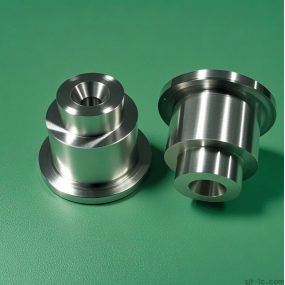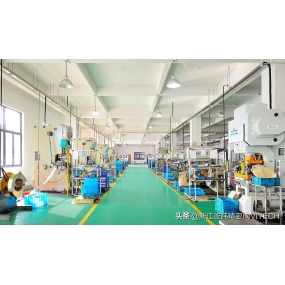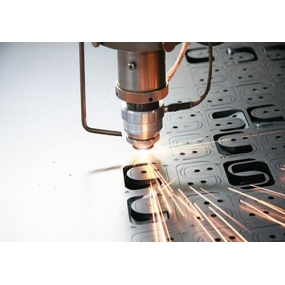1. Types of CNC tools
Commonly used numerical control milling cutters are divided into three types: flat-bottomed cutter, round nose cutter and ball cutter.
(1) Flat-bottomed knife
Flat-bottom cutter is also called flat cutter or end milling cutter. It is surrounded by the main cutting edge and the bottom is the secondary cutting edge. It can be used for roughening and clearing corners, finishing side planes and horizontal planes. Commonly used are ED20, ED19.05 (3/4 inch), ED16, ED15.875 (5/8 inch), ED12, ED10, ED8, ED6, ED4, ED3, ED2, ED1.5, ED1, ED0.8 and ED0.5. E is the first letter of End Mill; D indicates the diameter of the cutting edge.
Under normal circumstances, choose a knife with a larger diameter as much as possible when roughening, and install the knife as short as possible to ensure sufficient stiffness and avoid bouncing the knife. When selecting a knife, determine the shortest blade length and straight part length in combination with the processing area, and choose the most suitable knife available in our company.
If the side with a tilt is called a tilt knife, the tilt can be finished.
(2) Round nose knife
Round nose knife is also called flat bottom R knife, which can be used for rough, flat light knife and curved shape light knife. Generally, the angular radius is R0.1~ R8. Generally, there are integral and grain-inlaid knife handle knives. The grain-inlaid round nose knife is also called "flying knife", which is mainly used for large-area rough and horizontal light knives. Commonly used are ED30R5, ED25R5, ED16R0.8, ED12R0.8 and ED12R0.4. When machining deep areas, the length of the knife should be installed first to short the shallow area, and then to long the deep area to improve efficiency and not cut too much.
(3) ball knife
Ball knives are also called R knives and are mainly used for light knives and light knives in curved surfaces. Commonly used ball knives are BD16R8, BD12R6, BD10R5, BD8R4, BD6R3, BD5R2.5 (commonly used in processing flow channels), BD4R2, BD3R1.5, BD2R1, BD1.5R0.75 and BD1R0.5. B is the first letter of Ball Mill.
In general, the tool used for finishing should be determined by measuring the radius of the inner circle of the pattern to be processed, and a large knife and a small knife should be selected as far as possible.
2. Tool material
In metal cutting, the tool material is the cutting part, which has to withstand great cutting force and impact, and is subject to severe friction of the workpiece and chips, resulting in high cutting temperature. Its cutting performance must have the following aspects.
(1) High hardness: HRC62 or higher, at least higher than the hardness of the material being processed.
(2) High wear resistance: Under normal circumstances, the harder the material, the more carbon in the tissue, the finer the particles, and the more uniform the distribution, the higher its wear resistance.
(3) Sufficient strength and toughness.
(4) High heat resistance.
(5) Excellent thermal conductivity.
(6) Good craftsmanship and economy.
In order to meet the above requirements, current numerical control tools are generally made of the following materials:
(1) High-speed steel, such as the WMoAl series.
(2) Hard alloys, such as YG3, etc.
(3) New hard alloys, such as YG6A.
(4) Coated tools, such as TiC, TiN, and Al2O3.
(5) Ceramic tools can withstand high cutting speeds at high temperatures.
(6) Superhard tool materials.


 Spanish
Spanish Arabic
Arabic French
French Portuguese
Portuguese Belarusian
Belarusian Japanese
Japanese Russian
Russian Malay
Malay Icelandic
Icelandic Bulgarian
Bulgarian Azerbaijani
Azerbaijani Estonian
Estonian Irish
Irish Polish
Polish Persian
Persian Boolean
Boolean Danish
Danish German
German Filipino
Filipino Finnish
Finnish Korean
Korean Dutch
Dutch Galician
Galician Catalan
Catalan Czech
Czech Croatian
Croatian Latin
Latin Latvian
Latvian Romanian
Romanian Maltese
Maltese Macedonian
Macedonian Norwegian
Norwegian Swedish
Swedish Serbian
Serbian Slovak
Slovak Slovenian
Slovenian Swahili
Swahili Thai
Thai Turkish
Turkish Welsh
Welsh Urdu
Urdu Ukrainian
Ukrainian Greek
Greek Hungarian
Hungarian Italian
Italian Yiddish
Yiddish Indonesian
Indonesian Vietnamese
Vietnamese Haitian Creole
Haitian Creole Spanish Basque
Spanish Basque











